- HOME
- Ecommerce marketing
- Email marketing for ecommerce businesses
Email marketing for ecommerce businesses
Emails are the cornerstone of successful marketing, no matter the size of the business. 81% of SMB's rely on email marketing as their primary source of customer acquisition, and more than two-thirds of ecommerce customers have made a purchase as a direct result of email marketing. Even in the age of social media, emails are still a preferred medium of communication.
Ecommerce business owners and marketers who ignore email marketing do so at their own peril, and the statistics above stand testament to the medium's effectiveness. Beyond the ubiquity, email marketing's return on investment (ROI) heavily favors businesses and can be as high as 28%.
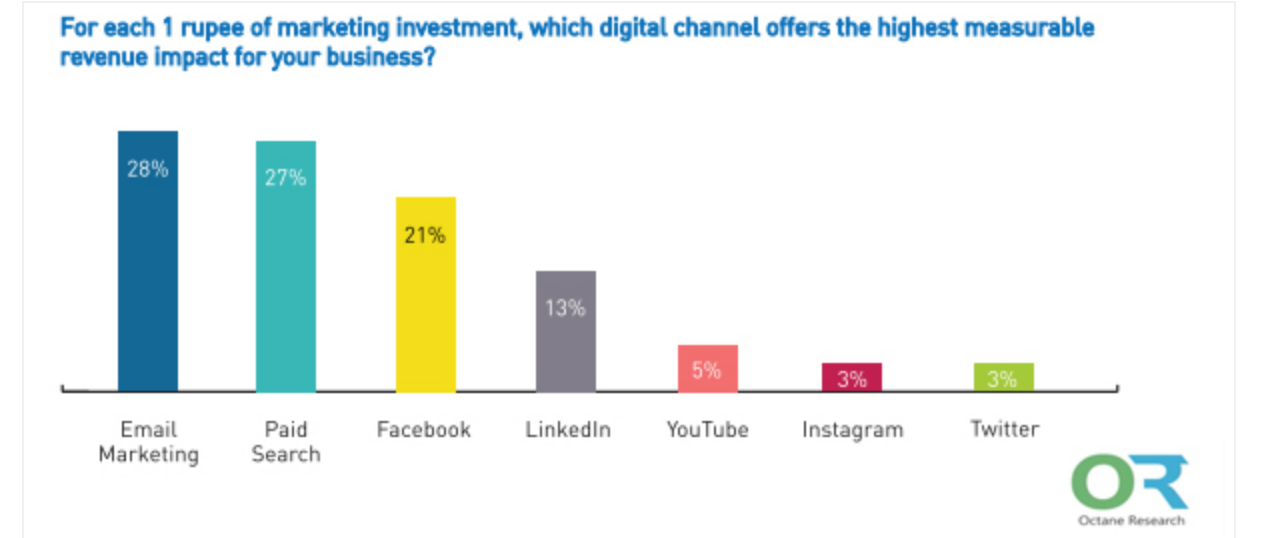
Description: Ecommerce marketers favor emails for business ROI.
With social media taking over most of our attention, email marketing has been maligned as outdated and ineffective. However, the data proves otherwise. Every business must aspire to be everywhere its customers are likely to be, and email is a trustworthy channel that most customers interact with regularly. It allows you to build an authentic connection with your customers.
With this in mind, we use email marketing for your ecommerce business. If so, this blog is a good starting point for you.
Benefits of email marketing
Before we begin, let's look at the benefits of email marketing:
It allows marketers to focus on individual customers or on segments of customers.
High ROI: It involves low monetary and time investments and produces a high return on investment. Data shows that for every $1 spent, ROI is $44.
Emails are easy to set up and scale. Most email marketing platforms let you set up your account and start sending emails in just a couple of hours, and there is often a free plan/trial period for you to test things out.
Engagement Value: You can use emails to engage with your customers and deliver content, blogs, or e-books that might be useful for them. This helps you create a recall for your business.
Personalization: Emails allow you to personalize your content, which grabs a prospect's attention. Personalization is a good starting point before communicating offers and value-added services.
Automation is the key to email marketing
Email automation allows you to send the right emails to the right people at the right moment without having to figure things out manually every single time. You just have to set up email automation once, and for every instance of the workflow that you have set up, your user will receive an email. The automation software takes care of the rest of the action required.
For example, when a user subscribes to your emailing list, a confirmation email gets sent out automatically. Customers also receive an order confirmation email for every purchase, one for returns issued, and one when shipping or refund status is updated. This way, as a store owner you have to work out the different instances for which an email is required and then set it up as automation.
Pro Tip: Many email marketing platforms like our own Zoho Campaigns help you set up email automation for your ecommerce store. Zoho Commerce also has a one-click integration set up with MailChimp.
Segmenting customer lists
Since emails are a mass medium, customers tend to ignore them unless they are personalized. Personalization starts with providing relevant content. You would want to send an email launching a new collection to a customer who bought from your last collection, wouldn't you?
Segmentation is the process of separating customers into various groups based on their activities in your ecommerce store. You can categorize your customers in groups such as first-time buyers, signed up to your newsletter for the first time, or loyal customers. Another category of note is that of dormant buyers, those customers who purchased in the past but are now inactive.
As an instance of effective automation, welcome emails can be set up for new subscribers or first-time buyers. You might then want to categorize buyers into a separate list and send them products related to their purchase in the next email in a few weeks. You may also set up a campaign to remind inactive users (customers who haven't bought from you in the past six months) to look at the latest product catalog. Segmentation allows you to do this, and you will notice your email marketing getting better over time after employing it.
Segmentation is a long-term process that requires you to constantly make changes. Carrying on from our last example, you may decide to send out emails to frequent buyers (who bought items from the last two emails you sent) every month or whenever you add a new product, but trigger an email to other customers only when you launch a new collection.
Overall, segmentation can significantly boost email marketing performance. In the screenshot below, we set up two campaigns for the same customer cohort. One campaign sent the same email to everyone, but the other split the list by gender and changed products and their images accordingly. The results were definitely better for the more targeted campaign.
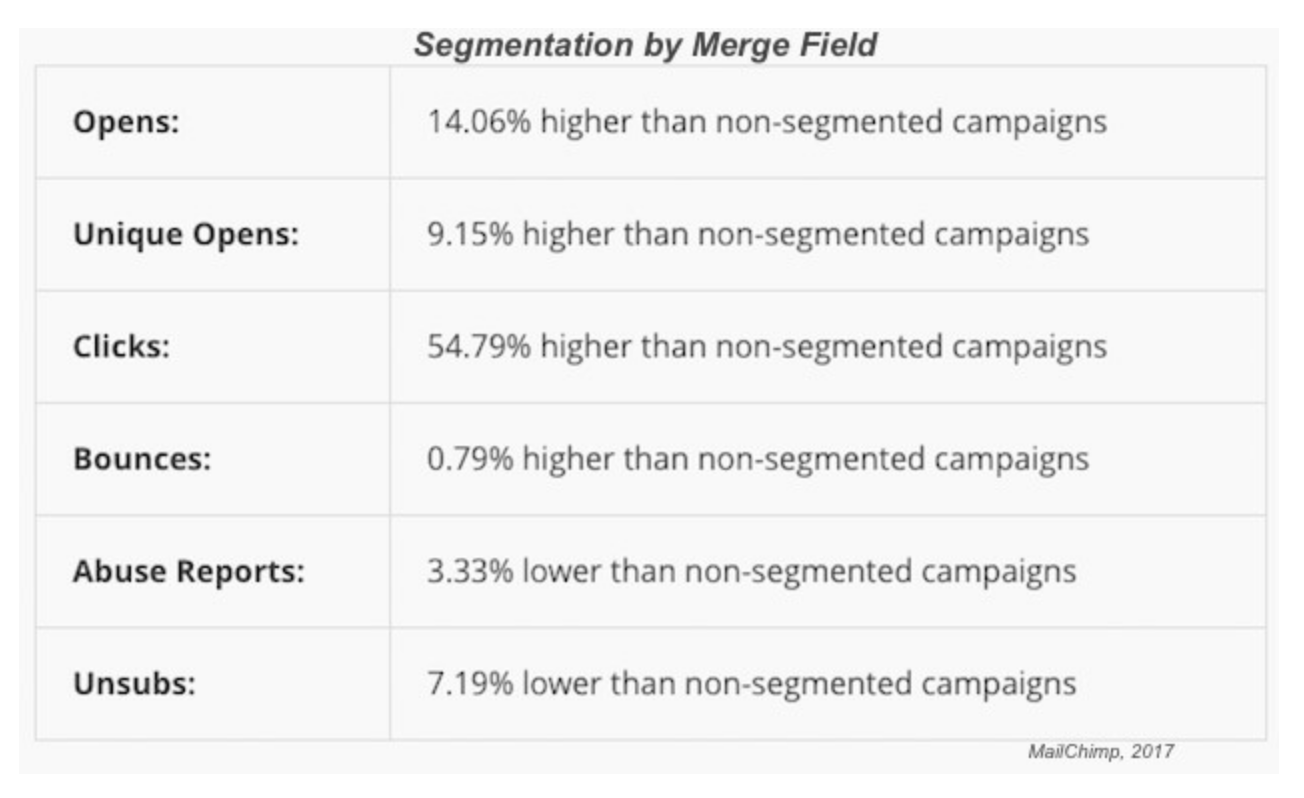
Measuring email marketing results
Marketing efforts need to be measured in outcomes. For email marketing, here are a few metrics that you should track:
Open rate: The percentage of subscribers who opened a particular email out of the total number of subscribers who received the email. Industry standards are at around 15%.
Click rate: Subscribers who perform the desired action (usually a click) against the subscribers who received the email. On average, 2% is a good conversion rate for your ecommerce business.
Bounce rate: The percentage of emails that could not be delivered versus the total number of emails sent. Ecommerce retailers usually have a bounce rate of 20-45%.
Unsubscribe rate: The percentage of users who opted out of receiving you emails in the future. Any number below 0.5% is acceptable for an ecommerce business.
Must-have email campaigns for ecommerce businesses
Sending appropriate emails without spamming your customers takes creativity and planning. Here are a few ideas that will help you get started with automation:
Welcome campaign
A Welcome Series of emails could help guide your newest customers around your business. You can give out incentives to customers to make the first purchase or to visit your most attractive category of products. A thank you email for first-time buyers would be a good place to start this series of emails. Ensure you communicate your brand values well and help familiarize your customers with everything about your brand such as:
Logo
Incentive and first-time purchase offer
Brand story and a few lines about your brand
Products in high demand with first-time buyers
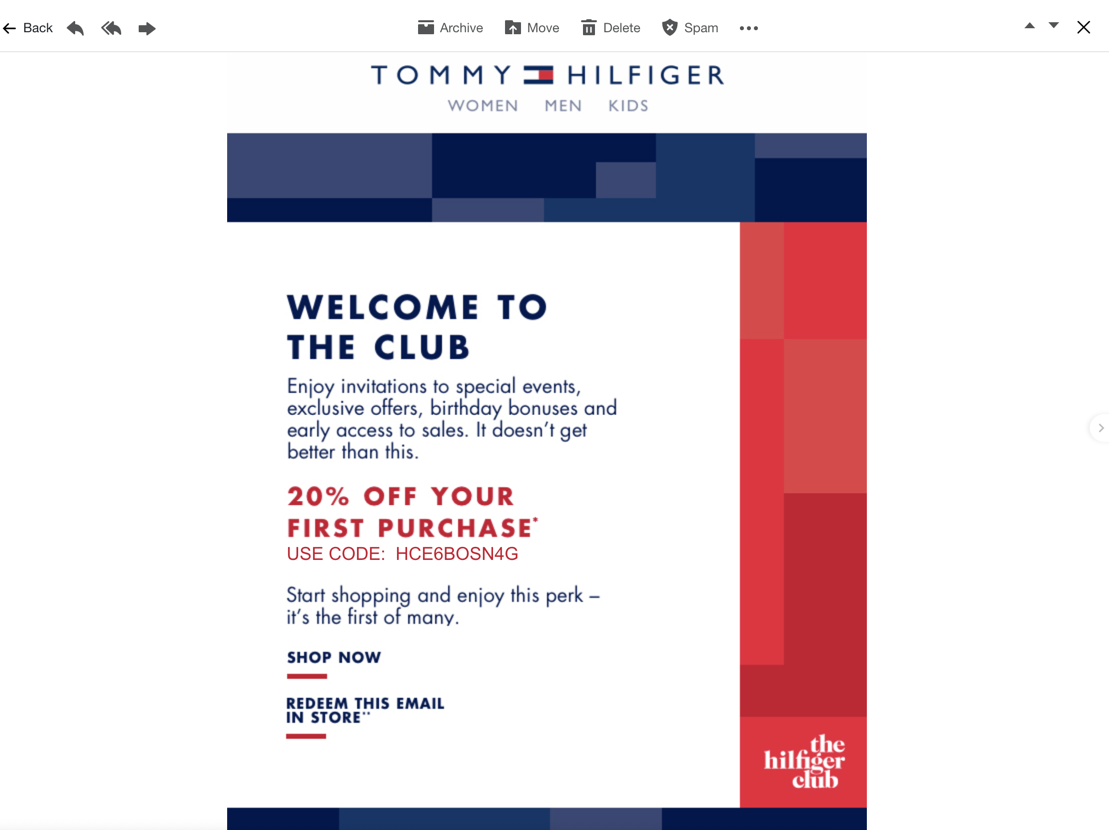
Tommy Hilfiger has some of the best welcome emails. They align with the brand colors, helping customers recognize the brand from their retail presence. The offer coupon also encourages viewers to make their first purchase.
Seasonal campaigns
Usually associated with the holiday season, you can position yourself as the brand of choice for your customers with these campaigns. Seasonal emails are all about gifts and shopping, so write up a relevant message and set up your campaigns in advance. Your messaging needs to include information on delivery times and any promotions that you are running.
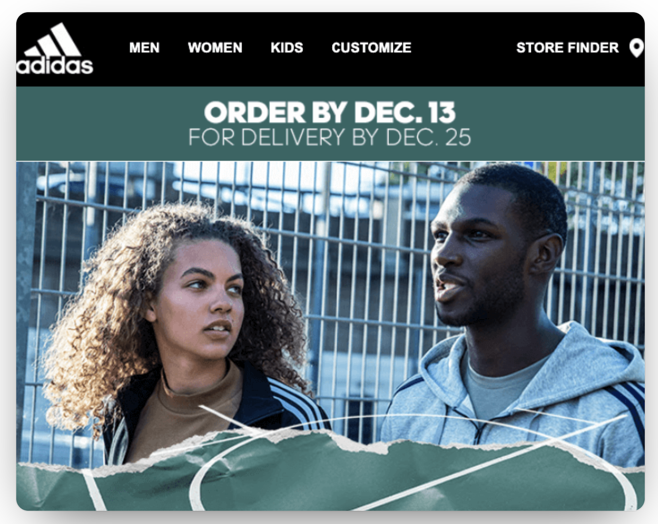
Adidas reassures customers of guaranteed delivery before Christmas as long as goods are purchased before December 13th. How is that for a clear message?
Cart Abandonment campaign
Customers on ecommerce websites tend to be indecisive and fickle. This creates a big issue with visitors adding products to their shopping cart and then abandoning them. An important way to bring some of these customers back is using tactics such as cart abandonment emails. Like the name suggests, these can be sent to customers to remind them of the products they left behind in their carts. With the right messaging, these email campaigns can drive customers to finish their purchases. Try using the following parameters when crafting your cart abandonment emails:
A catchy banner
Call to Action (CTA) — A link that directs your customers back to the cart
List of products left in the cart
Coupon code (optional) — for that extra incentive to complete the purchase
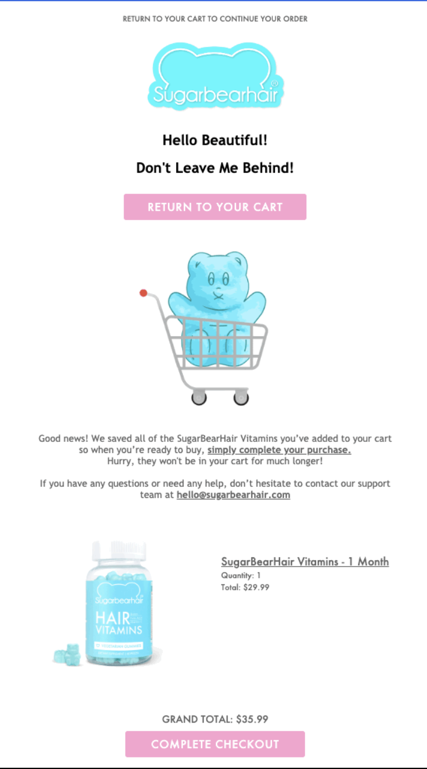
Customers at Sugarbear receive cute emails that encourage them to complete their purchase. The colors really draw attention to the CTAs.
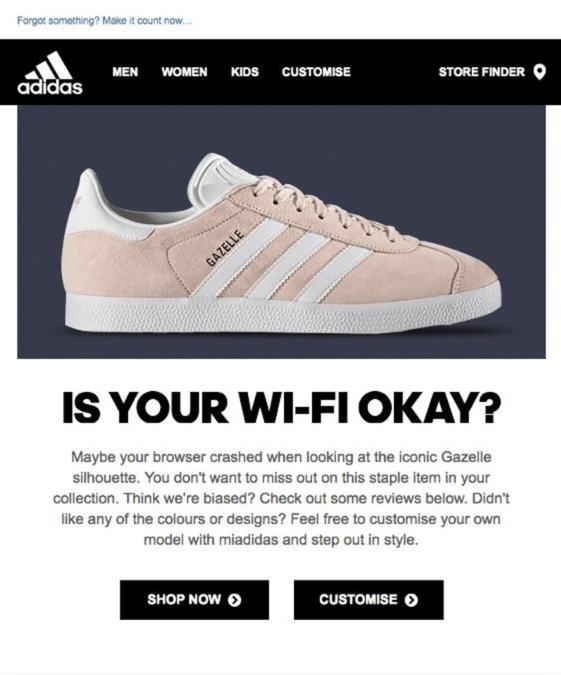
Adidas uses a fun copy in their cart abandonment emails. This way the emails come across as amusing rather than unwanted.
Purchase confirmation campaign
An ecommerce business will usually send out an email to confirm the order the customer just placed. Use this opportunity to thank the customer for their purchase, remind them of ongoing offers and products that might work well with their recent purchase, and provide links to track their order. Build excitement as they await delivery. Thank you emails play a major role in the customer experience as well, and it is important that the customer feels in control of the transaction.
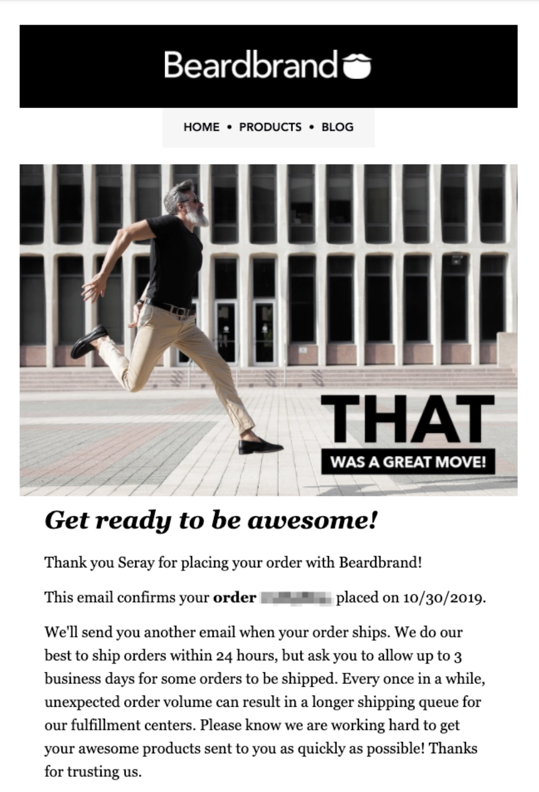
Here's an example from Beardbrand. For every order placed, a thank you and tracking email is sent to the customer. Notice how the brand builds excitement for the impending arrival of the product and makes the customer feel good about their purchase.
Post-purchase campaign
Buyer's remorse is real in ecommerce, and it's important to combat it. Following up with a customer after they received the product is a great way to improve the user experience. Reminding your customers about the return policy and refund process will put them at ease and help thwart buyer's remorse.
Remember to prompt the customer to leave a product review and incentivize them to talk about their purchase on social media. Additional information like tips to maintain the product and maximize value is also appreciated by customers.
.png)
Martha Stewart is a digital magazine that curates a list of trending products. Observe the language here—it is usually geared to help their customers make the purchase decision and overcome buyer's remorse, all while building a relationship of trust with the business!
Re-engagement campaign
According to research, nearly 30% of a business's customers become dormant every year. It's important that you create an automation to target this segment. Consider sending re-engagement campaigns to customers who haven't purchased from you in the past 12 months.
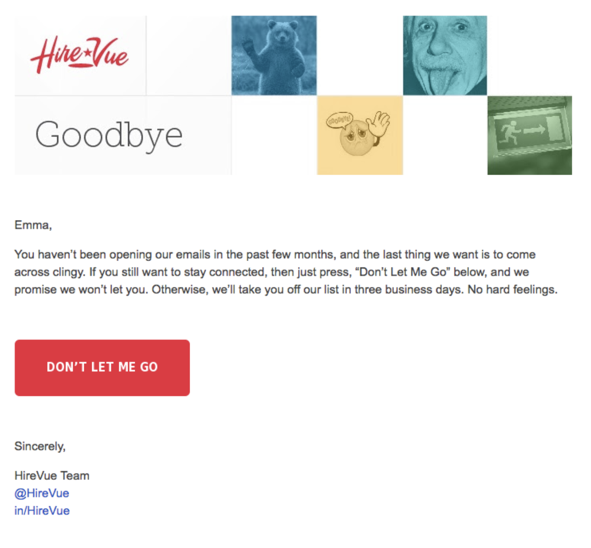
HireVeu tracks the click rate of emails that are sent to customers. Using this data they segment the inactive audiences and sends them a goodbye email. It's a healthy practice to regularly clean the subscription list to avoid being marked as spam.
Re-engagement campaigns work best when you trigger the emotions of your customers and remind them of the pain you resolved for them in the past. A series of emails including one with the review the customer wrote for you (if available), a coupon code to re-engage them with your brand, and finally, one that reminds them of their love for the product they bought from you are a few ideas you should consider.
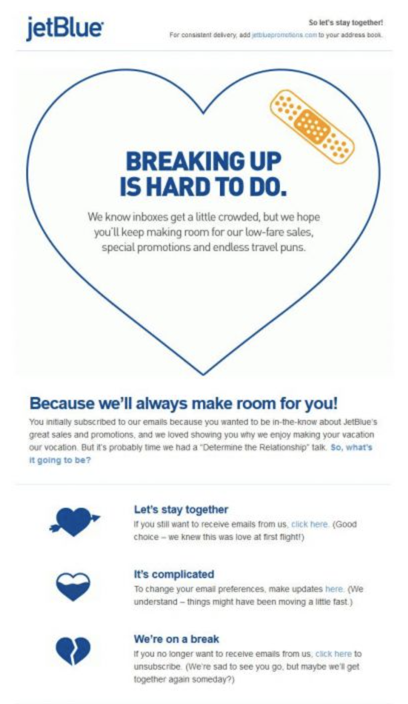
Jetblue sends really sweet break-up emails for their re-engagement campaign. Their concept is easy to understand and trigger an emotional response from their customers.
Pro tip: According to research, the more emails you send to your customers, the less likely they are to open them. Consider limiting the number of emails any one customer is likely to receive to three a month.
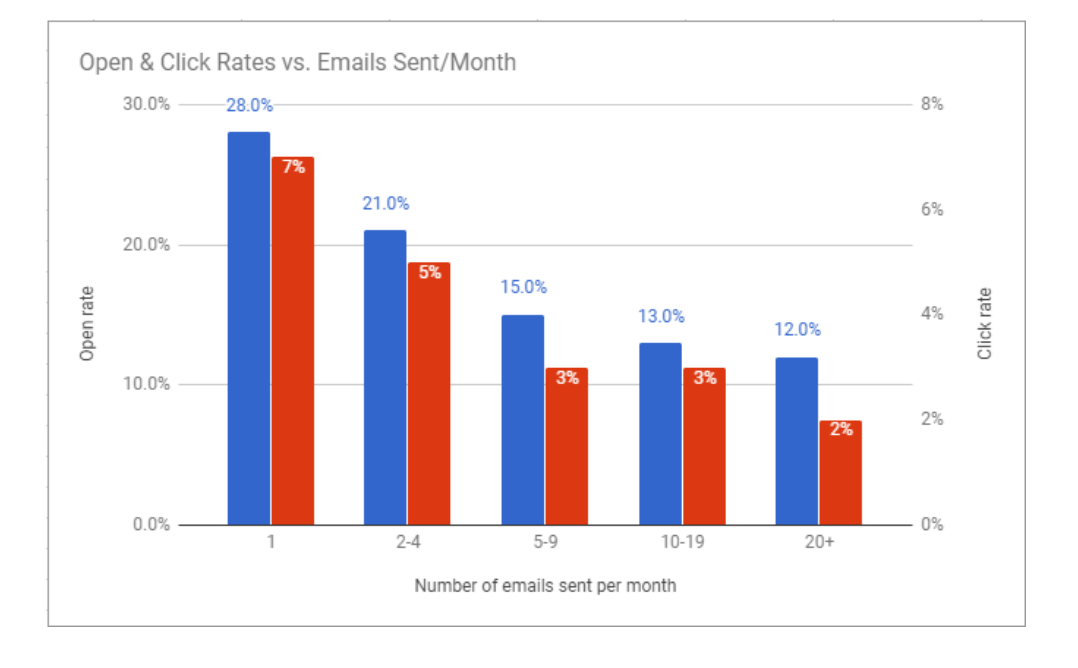
Product review automation
Customer feedback is important for every business, but ecommerce absolutely thrives on reviews from buyers. Product review campaigns are the perfect way for brands to collect as many authentic reviews from customers as they can. This automation can prompt customers to share their thoughts about their experiences with your products and your business.
Consider incentivizing writing a product review with an offer, and ensure that your support team resolves any issues effectively. Customer engagement of this nature will increase trust in your business and build social proof.

MarkaStore offers its customers a discount coupon for every review that they write on their website. This is why they have some of the most reliable reviews for their products on their website.
Conclusion
Email marketing can make a big impact on your ecommerce business. It is a cost-effective and scalable marketing tactic. The best way to approach email marketing is via automation. From recovering lost revenue to building trust with your customers, we recommend using email marketing actively.
Commerce Insights is a blog maintained by Zoho Commerce for ecommerce merchants. We discuss topics relating to product features, getting started with ecommerce, and marketing ideas for businesses.
We want you to be a part of this journey in building an ecommerce community. Please send us your thoughts, suggestions, and ideas at marketing@zohocommerce.com.
If you wish to publish an article on the platform, please send it to the same email.
For support-related queries, please write to support@zohocommerce.com.
